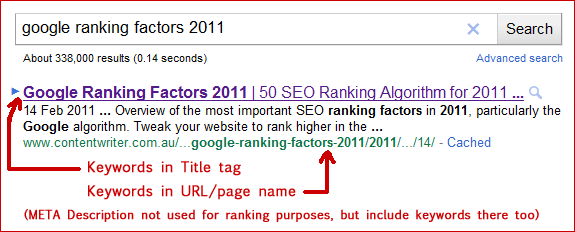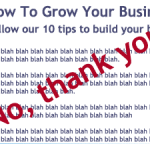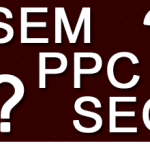SEO: 50 Google Ranking Factors in 2011
You know that Google – and other search engines – use many different signals to determine how to rank websites on their search results pages. But how many SEO ranking factors can you actually name? 10? 20?
Google says it takes more than 200 factors into account in its ranking algorithm while Bing claims to use over 1000 signals. Of course, these ranking factors are not made public. Search engine algorithms also change over time, with new signals being added and others dropped.
SEO experts have managed to get a pretty good grasp on at least the most imporant factors that play a role in search engine rankings.
Below, I’m listing 50 Google ranking factors that are important in 2011. For easy reference, I’ve put them into three different categories:
- On-page ranking signals: keyword-related
- Other on-page and site-wide ranking factors
- Off-page/external ranking signals (links & social media)
50 SEO Ranking Factors in 2011
*** My personal Top 15 search engine ranking factors are marked with three red asterisks.
On-Page Ranking Signals – KEYWORDS:
- Keywords in the Title tag (ideally at the beginning) ***
- Keywords in the root domain name (keyword.com) ***
- Keyword use/density in the body copy (higher up better than further down; don’t overdo it!) ***
- Keywords in H1-H6 headline tags (ideally H1/H2 and used as the first word/words)
- Keywords emphasised with bold/strong tags within copy
- Keywords in anchor text of incoming links from other pages to this page ***
- Keywords in anchor text of internal links on the page
- Keywords in anchor text of external links on the page
- Keywords in the subdomain name (keyword.domainname.com)
- Keywords in the page name URL (domain.com/keyword.html) ***
- Keywords in the page folder URL (domain.com/keyword/page.html)
- Keywords in ALT IMG attributes of images on the page
- Keywords in image names (keyword.jpg)
Example of a Search Engine Results Page (SERP) showing relevance of factors 1 and 10 above:

On-Page/Site-Wide Ranking Signals – OTHER:
- Having unique and good quality content on the page ***
- Creating fresh content regularly by adding new pages and/or updating existing pages
- Google PageRank of the page ***
- Authority/trustworthiness of the domain ***
- Using a logical site architecture with useful hierarchies
- Having a technically sound and bug-free website ***
- Location of page in relation to the site’s structural hierarchy
- Domain age & registration history
- Reliable hosting/server for maximum website uptime
- Influence of other domains hosted on a shared server (avoid ‘bad neighbourhoods’)
- Quality of outgoing links (to reputable, trustworthy websites)
- Page loading time, i.e. the speed of the website
- TLD type (top-level domain, e.g. .com, .net, .gov, .edu, .co, .info etc.)
- Country-code TLD (domain extension) where relevant (e.g. .com.au in Australia)
- Location of server (ideally in country where most of your visitors are searching from)
- Click-through rates to your page from the search results (this is slightly speculative)
- Bounce rate and time spent on the page by visitors (also somewhat speculative)
Off-site ranking factors – EXTERNAL LINKS & SIGNALS:
- Keywords in anchor text of links from other websites ***
- Popularity of incoming links
- Quality/authority of web page linking to you ***
- Quality/reputation of domain that links to you ***
- Diversity of incoming links (links from many unique domains) ***
- Relevancy of content on the linking page to your page ***
- Links from authorities on the topic your page is about
- Location of link (e.g. body copy better than footer, first link better than last)
- Follow/No-Follow status of the link ***
- Number of links on the linking page
- Keywords in ALT IMG attribute of image links
- Age of website linking to you
- Age of web page linking to you
- Domain type of website linking to you
- Server location of website linking to you
- Natural diversity in anchor text of incoming links (100% exact keyword links is unnatural)
- Number of mentions, listings & citations on quality websites and directories
- Popularity of social media links (shared via Twitter, Facebook etc.)
- Quality and popularity of your social media profile linked to your website
- Popularity of links from bookmarking sites
This Top 50 is my personal list of important ranking factors. They are not listed in exact order of importance (which isn’t even possible because everyone has a different opinion on which factors are important or not that important). However, factors listed towards the top of each of the three lists above are generally considered more important than factors found further down the lists.
This is not an exhaustive list and there are certainly many other factors that play small roles in Google’s and Bing’s ranking algorithms. There are also countless negative ranking factors – things you can do WRONG with your website, resulting in lower rankings. I have not covered these here but may do so in a separate future blog post.
If you feel I have missed SEO ranking factors that you think are quite important, please leave a comment below.
![]()
And lastly, if you need help with your website SEO or content, please contact me, Micky Stuivenberg. I am a professional SEO Web Copywriter with international SEO experience. I would be happy to help you get better search engine rankings, more visitors and more sales or enquiries on your website.


Hi Mickey, great post! I am also an SEO copywriter, and I’ve worked as marketing director for the past 5 years with an SEO company. This is an awesome list! I rarely see such a deep knowledge of what goes into SEO beyond the content aspect from copywriters. I am going to share it on my FB page, too. Drop by if you get the chance (www.facebook.com/lisabanks45) I’m glad I’ve come up on your blog. Looking forward to reading more!
Hi Lisa, thank you so much for your kind words. Besides being a web copywriter, I am also a tutor for online SEO courses at Search Engine College and am very intrigued by the numerous (and ever changing) factors that are involved in search engine rankings.
Thanks also for sharing my post on your Facebook page, I appreciate that and I hope some of your followers will find the list of interest too. I love having my own SEO copywriting business and it sounds like you do too. All the best with your business.
One more question, Micky, what program did you use to cut and markup the SERP result above? I’ve been looking for something I can use with more functionality than my current snipping tool but not as involved as, say, Photoshop.
I used a simple snipping tool but then used Photoshop to add my comments. There may be an easier way to do both in the one program/tool, but I’m comfortable using Photoshop so for me that’s the quickest way to do what I wanted to do.
May I ask u some question, please?
In “On-Page Ranking Signals – KEYWORDS” this part, you write this factor is important, Keyword use/density in the body copy (higher up better than further down; don’t overdo it!), what is “body copy”? I can’t understand this means.
Thank you.
Hi Jessica, with “body copy” I mean the copy (textual content) in the main body area of the page, i.e. not in the header, footer or sidebar.